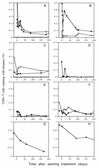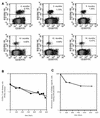Decay kinetics of human immunodeficiency virus-specific effector cytotoxic T lymphocytes after combination antiretroviral therapy
- PMID: 9847391
- PMCID: PMC103892
- DOI: 10.1128/JVI.73.1.797-800.1999
Decay kinetics of human immunodeficiency virus-specific effector cytotoxic T lymphocytes after combination antiretroviral therapy
Abstract
Little is known of the changes in human immunodeficiency virus type 1 (HIV-1)-specific effector cytotoxic T lymphocytes (CTL) after potent antiretroviral therapy. Using HLA/peptide tetrameric complexes, we show that after starting treatment, there are early rapid fluctuations in the HIV-1-specific CTL response which last 1 to 2 weeks. These fluctuations are followed by an exponential decay (median half-life, 45 days) of HIV-1-specific CTL which continues while viremia remains undetectable. These data have implications for the immunological control of drug-resistant virus.
Figures



References
-
- Ahmed R, Gray D. Immunological memory and protective immunity: understanding their relation. Science. 1996;272:54–60. - PubMed
-
- Altman J, Moss P A H, Goulder P, et al. Direct visualization and phenotypic analysis of virus-specific T lymphocytes in HIV-infected individuals. Science. 1996;274:94–96. - PubMed
-
- Autran B, Carcelain G, Li T S, et al. Positive effects of combined antiretroviral therapy on CD4+ homeostasis and function in advanced HIV disease. Science. 1997;277:112–116. - PubMed
-
- Carr A, Emery S, Kelleher A, et al. CD8+ lymphocyte responses to antiretroviral therapy of HIV infection. J Acquired Immune Defic Syndr Hum Retrovirol. 1996;13:320–326. - PubMed
Publication types
MeSH terms
Substances
Grants and funding
LinkOut - more resources
Full Text Sources
Other Literature Sources
Medical
Research Materials

